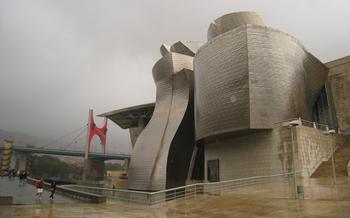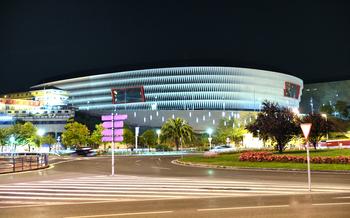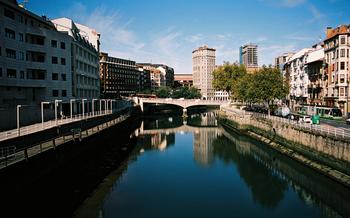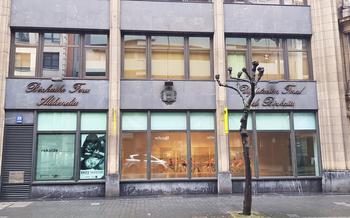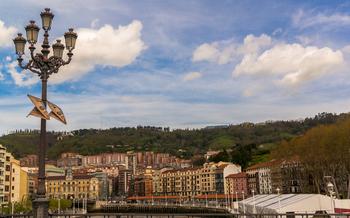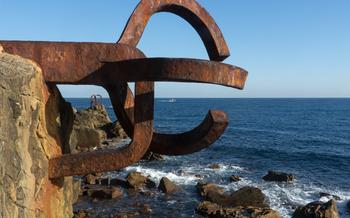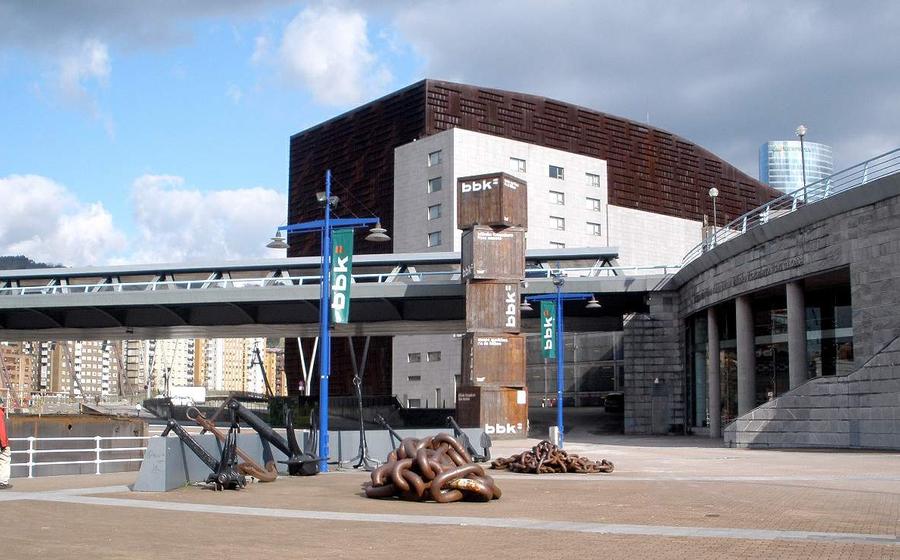
Museo Marítimo Ría de Bilbao
- The Maritime Museum of Bilbao
- Exploring the Museum Galleries
- Shipbuilding and Maritime Heritage
- The Abra Estuary
- Maritime Trade and Commerce
- Whaling and Fishing Traditions
- Interactive Exhibits and Workshops
- Guided Tours and Educational Programs
- Museum Shop and Bookstore
- Planning Your Visit
- Insider Tip: Revealing Hidden Gems
The Maritime Museum of Bilbao
The Maritime Museum of Bilbao, also known as and culture, showcasing the rich seafaring traditions of the Basque Country. Inaugurated in 2003, the museum has become a prominent attraction for visitors and locals alike, offering an immersive journey into the world of shipbuilding, maritime trade, and the captivating stories of the sea.
Located in the heart of Bilbao's maritime district, the museum is easily accessible by public transportation or car. Its striking architectural design, featuring a modern glass and metal facade, blends seamlessly with the city's industrial heritage. The building's unique shape, resembling a ship's bow, is a testament to the museum's maritime focus. Inside, visitors are welcomed by a spacious and light-filled atrium, setting the stage for an engaging and educational experience.
Exploring the Museum Galleries
The Museo Marítimo Ría de Bilbao is divided into several thematic galleries, each offering a unique perspective on the maritime history and culture of the Basque Country. Visitors can embark on a journey through the ages, starting with the ancient maritime traditions of the Basque people and progressing to the modern era of shipbuilding and maritime trade.
One of the highlights of the museum is the Ship Model Gallery, which showcases a collection of intricate and detailed ship models. These models provide a glimpse into the evolution of shipbuilding techniques and designs, from early sailing vessels to modern-day cargo ships. Visitors can admire the craftsmanship and precision that went into creating these miniature replicas, which offer valuable insights into the history of maritime exploration and trade.
Another must-see gallery is the Maritime Artifacts Gallery, which features a diverse collection of objects related to the sea. Visitors can examine ancient navigation instruments, fishing gear, diving equipment, and other artifacts that tell the stories of the people who lived and worked on the water. These objects provide a tangible connection to the past and help visitors understand the challenges and triumphs of life at sea.
The museum also offers a range of Interactive Exhibits that engage visitors of all ages. These exhibits allow visitors to experience the thrill of sailing a ship, learn about the science of navigation, and even try their hand at fishing. The interactive exhibits are a great way to make learning fun and memorable, and they provide a deeper understanding of the maritime world.
Shipbuilding and Maritime Heritage
Bilbao's maritime history is deeply intertwined with shipbuilding, a tradition that dates back centuries. The city's strategic location on the Nervión River and its access to the Atlantic Ocean made it an ideal hub for shipbuilding activities. The Museo Marítimo Ría de Bilbao pays homage to this rich heritage through its captivating exhibits on Basque shipbuilders and their contributions to the maritime industry.
One of the highlights of the museum is the gallery dedicated to the Euskalduna Shipyard, a once-thriving shipyard that played a pivotal role in Bilbao's maritime development. Through interactive displays, visitors can learn about the shipyard's operations, its impact on the local economy, and its contributions to the advancement of shipbuilding technologies.
The museum also showcases the evolution of shipbuilding techniques and technologies over the centuries. From traditional wooden sailing ships to modern steel vessels, visitors can trace the journey of shipbuilding innovation and engineering prowess. Detailed models, historical documents, and interactive exhibits bring to life the stories of the skilled shipbuilders who shaped Bilbao's maritime legacy.
The Abra Estuary
The Abra Estuary, a vital component of Bilbao's maritime history, serves as the focal point of several captivating exhibits within the Museo Marítimo Ría de Bilbao. Visitors delve into the intricate ecosystem of the estuary, exploring its diverse biodiversity and the conservation efforts dedicated to preserving its natural wonders. Interactive displays illuminate the delicate balance between human activity and environmental stewardship, highlighting the importance of sustainable practices in safeguarding this unique natural treasure.
One of the highlights of the estuary-focused exhibits is the interactive touch tank, where visitors can engage with marine life up close. This hands-on experience allows them to learn about the fascinating creatures that call the estuary home, fostering a deeper appreciation for the delicate ecosystem they inhabit.
Another captivating exhibit showcases the history of fishing in the Abra Estuary. Visitors learn about the traditional fishing techniques employed by Basque fishermen, gaining insights into the challenges and rewards of this ancient practice. The exhibit also sheds light on the environmental impact of fishing, encouraging visitors to reflect on the importance of sustainable fishing practices.
The Museo Marítimo Ría de Bilbao's dedication to showcasing the Abra Estuary extends beyond its exhibits. The museum actively participates in conservation initiatives aimed at protecting the estuary's fragile ecosystem. Visitors are encouraged to support these efforts by contributing to the museum's conservation fund, ensuring the long-term preservation of this natural marvel.
Maritime Trade and Commerce
Bilbao's strategic location at the mouth of the Nervión River made it a natural hub for maritime trade and commerce. The city's port became a bustling center of activity, with ships from all over the world docking to load and unload goods.
The museum's exhibits on maritime trade and commerce provide a fascinating glimpse into this important aspect of Bilbao's history. Visitors can learn about the different trading routes that were established, the types of goods that were transported, and the role that Bilbao played in the rise of the port city.
One of the highlights of the exhibits is a replica of a medieval trading ship, complete with its cargo of goods. Visitors can also see exhibits on the Basque merchants who played a key role in the city's maritime trade, as well as the impact that the trade had on Bilbao's economy and culture.
The exhibits on maritime trade and commerce are a valuable resource for anyone who wants to learn more about the history of Bilbao and its role in the development of global trade. They offer a fascinating insight into the city's rich maritime heritage and the importance of the sea to its people.
Whaling and Fishing Traditions
Bilbao's maritime history is closely linked to whaling and fishing activities. As a major port city, Bilbao played a significant role in the Basque whaling industry, which dates back to the Middle Ages. The museum houses a dedicated gallery that explores this fascinating aspect of the city's past.
Exhibits on whaling techniques and equipment provide insights into the challenges and dangers faced by Basque whalers. Visitors can learn about the different types of whales hunted and the methods used to catch them, from traditional harpoons to more modern whaling technologies.
The gallery also showcases the various uses of whale products, such as oil for lighting and heating, baleen for making corsets and umbrellas, and spermaceti for candles and cosmetics. Interactive displays allow visitors to experience the thrill of a whale hunt and learn about the impact of whaling on marine ecosystems.
In addition to whaling, the museum also highlights Bilbao's rich fishing traditions. Exhibits on fishing methods, from traditional line fishing to modern trawling techniques, provide a glimpse into the lives of Basque fishermen. Visitors can explore the different types of fish caught in the Bay of Biscay and learn about the importance of sustainable fishing practices for the preservation of marine resources.
Interactive Exhibits and Workshops
The Museo Marítimo Ría de Bilbao offers a variety of interactive exhibits and workshops designed to engage visitors of all ages and make learning about maritime history fun and interactive.
One popular activity is the ship model building workshop, where visitors can learn the basics of shipbuilding and construct their own miniature vessel. The museum also offers navigation workshops, where participants can learn how to use traditional navigational tools such as compasses and sextants.
For those interested in maritime crafts, there are workshops on rope making, knot tying, and sail making. These workshops provide a hands-on opportunity to learn about the traditional skills used by sailors and shipbuilders throughout history.
In addition to these workshops, the museum also features a number of interactive exhibits that allow visitors to experience maritime history firsthand. Visitors can try their hand at steering a virtual ship, explore the depths of the ocean in a simulated submarine, and even experience the thrill of a storm at sea.
These interactive exhibits and workshops not only make learning about maritime history fun and engaging but also provide a deeper understanding of the challenges and skills that sailors and shipbuilders faced in the past.
Guided Tours and Educational Programs
Enrich your visit to the Museo Marítimo Ría de Bilbao with guided tours led by knowledgeable museum staff. These experts will take you on a journey through the galleries, providing insightful commentary on the exhibits and sharing intriguing stories about Bilbao's maritime heritage. Tours are available in multiple languages and can be tailored to specific interests, making them suitable for both casual visitors and maritime enthusiasts.
For a more immersive experience, consider participating in the museum's educational programs. Designed for schools and groups of all ages, these programs offer interactive workshops, hands-on activities, and guided tours that bring maritime history to life. Children can learn about shipbuilding, navigation, and marine life through engaging activities, while adults can delve deeper into the museum's collection with guided discussions and lectures.
By taking advantage of guided tours and educational programs, you'll gain a deeper understanding of Bilbao's rich maritime heritage and leave the museum with a newfound appreciation for the city's connection to the sea.
Museum Shop and Bookstore
The Museo Marítimo Ría de Bilbao offers a well-stocked museum shop where you can find a variety of maritime-themed souvenirs, books, and gifts to commemorate your visit. Whether you're looking for a unique piece of jewelry, a model ship to add to your collection, or a book about the maritime history of Bilbao, you're sure to find something to suit your taste.
The museum shop is located on the ground floor of the museum and is open during regular museum hours. It's a great place to browse and find gifts for friends and family, or to simply treat yourself to a special souvenir.
By purchasing items from the museum shop, you not only get a unique and meaningful memento of your visit but also support the museum and its ongoing initiatives. The revenue generated from the shop helps to fund educational programs, exhibitions, and research projects that contribute to the preservation and promotion of Bilbao's rich maritime heritage.
Planning Your Visit
To ensure a memorable experience at the Museo Marítimo Ría de Bilbao, it's crucial to plan your visit effectively. Admission fees are quite reasonable, with discounted rates for students, seniors, and groups. The museum's hours of operation vary depending on the time of year, typically opening from Tuesday to Sunday. It's advisable to check the official website or contact the museum directly for the most up-to-date information.
For a comprehensive exploration of the museum, guided tours are highly recommended. Knowledgeable museum guides will lead you through the galleries, providing insights into the exhibits and Bilbao's maritime history. These guided tours are available in multiple languages and can be booked in advance to avoid any disappointment.
If you're visiting with children or a group, the Museo Marítimo Ría de Bilbao offers educational programs tailored to different age groups. These programs include interactive workshops, hands-on activities, and educational materials that make learning about maritime history fun and engaging for everyone. For groups, it's advisable to make reservations in advance to ensure availability.
To make the most of your visit, plan a recommended itinerary. Start with the introductory gallery to gain an overview of Bilbao's maritime heritage. Then, delve deeper into the thematic galleries, exploring the ship models, maritime artifacts, and interactive exhibits. Don't miss the Euskalduna Shipyard section to learn about Bilbao's shipbuilding tradition and its impact on the city's economy.
Finally, remember to budget enough time to explore the museum at a leisurely pace. Allow at least two to three hours to fully appreciate the exhibits and engage with the interactive activities. With so much to see and learn, the Museo Marítimo Ría de Bilbao promises an enriching and unforgettable experience for visitors of all ages.
Insider Tip: Revealing Hidden Gems
For an unforgettable experience at the Maritime Museum of Bilbao, venture beyond the main galleries to uncover hidden gems that offer breathtaking views and exclusive insights. One such secret spot is the rooftop terrace, accessible via a discreet staircase near the entrance. From this vantage point, you can soak in panoramic vistas of the city skyline, the meandering river, and the vast expanse of the Abra estuary.
Another hidden gem is the museum's restoration workshop, where skilled conservators meticulously restore and preserve artifacts and ship models. Visitors are welcome to observe the intricate work and gain a deeper understanding of the museum's dedication to preserving maritime heritage.
Don't miss the opportunity to explore these hidden corners of the Maritime Museum of Bilbao, where history, culture, and breathtaking vistas converge to create a truly immersive and memorable experience.


